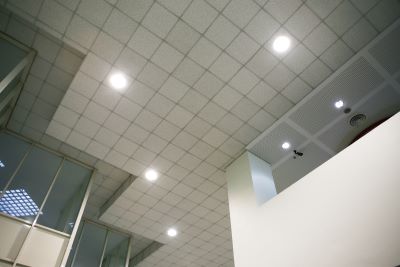Lecture halls are a staple on almost every college campus. These multi-functional rooms are used regularly as classrooms but often play host to additional events such as guest speakers and presentations. When this happens, Acoustical Sound Treatment can be a major issue, and needs to be addressed during project design.
Though lecture hall uses may vary, speech remains the constant factor across events. In order for speakers to successfully communicate with an audience, there must be high speech intelligibility and low background noise. To achieve this type of listening environment, consider the tips below when providing sound treatment for a lecture hall.
Case Study: Acoustic Treatment in Healthcare Lecture Hall
Sound Treatment Approach for Lecture Halls and Education Facilities
There are a few different approaches we recommend that can be taken to improve lecture hall acoustics:
- Acoustically Treat a Lecture Hall with Acoustic Wall Panels
- Design Lecture Halls with Sloped Floors to Improve Line of Sight Auditory Comprehension
- Be Sure Mechanical Systems Such as HVAC are Placed Further From The Speaker and Students
- Install a Proper Speaker System if Speakers Will Be Using Amplified Speech
Sound-Absorbing Panels – Acoustic Treatment Options for Lecture Halls

Decreasing reverberations times will help reduce background noise, which will make listening easier. To achieve lower reverberation times, side walls should be treated with sound-absorbing material. Acoustic-absorption panels are one of the most popular choices for this type of treatment.
The effectiveness of acoustic treatment is generally in proportion to the square footage used – if several hundred square feet of acoustic treatment is used in an average sized lecture hall, it is unlikely that significant reverberation will build up in the space.
A common question is how should the acoustic panels or stretched fabric wall systems be spread out? In reality, there is no simple algorithm to drive the geometric placement of these absorption products. However, the best heuristic, or rule of thumb, is spread them as widely as possible, so that the treatment is never concentrated in a single area. Furthermore, acoustic treatments in lecture halls should not be placed unnecessarily high, since lower reflections may have more effect than those reflecting high off of the walls.
Sound Diffusion: Distance from Speaker to Listener
It may sound evident, but keeping as short of a distance as possible between the last row of audience seating and the speaker is essential. Not only will this make listening easier for the entire audience, it will also create better sight lines so that everyone in the room can both see and hear the speaker.
Staggering the sight lines between adjacent rows means that you can diminish the slope of the floors needed to provide clear vision, which is an essential component for clear auditory comprehension.

Sound Treatment for Mechanical Systems
Mechanical systems are often the main source of intrusive noise in classrooms and lecture halls. HVAC and other mechanical systems are needed to keep the building running, but can often create a lot of noise
For new buildings, you can minimize noise by locating machinery away from walls to avoid additional structure-borne noise from vibrations. You can also use buffer zones, like storage facilities, to build distance between noise-sensitive rooms and machinery.
If working on an existing building where machinery cannot be relocated, treat the parts with sound-absorbing material to reduce noise at the source. Air ducts and pipes can be treated using pipe-lagging, a product that combines a layer of 1 lb/sf mass loaded vinyl with a layer of 3 pcf fiberglass, which works to block and absorb loud noises caused by HVAC and water flowing through pipes.
Sound Reinforcement
For smaller rooms, the speaker’s voice is typically loud enough on its own to suffice. With larger rooms, or speakers with weak voices, a sound reinforcement system complete with speakers and microphones may be required.
The use of amplified speech in a space can usually make any echo that is created worse than it would be without amplified speech. In this case, acoustic treatment with acoustic wall panels will likely be required to avoid any speech intelligibility issues for students during class, or members of an audience during a speaking event.
How to Improve Lecture Hall Acoustics
Creating the ideal listening environment for speech-heavy locations is simple with these tips. In an area that is so critical for speech comfort and intelligibility, acoustic treatment must be considered during the design phase of these classrooms. Ensure that you implement sufficient acoustic treatment, and design geometries for clear vision and minimal reverberation.



